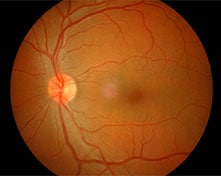Health Conditions and Your Eyes
What is hypertension and high intraocular pressure?
Hypertension means having high blood pressure. Hypertension in the eyes, known as Ocular Hypertension, can lead to high intraocular pressure (IOP), a condition where the pressure in your eyes is too high.
When you have high IOP, the fluid that fills the front chamber of your eye, known as the aqueous humor, is unsettled. If your eyes produce too much aqueous or cannot drain enough of it, your IOP will be high.
People over the age of 40 and people with a family history of hypertension or glaucoma are at a higher risk of having high IOP. Unfortunately, IOP symptoms don't occur until optical damage has been done. Without treatment, some IOP symptoms can lead to blurred vision, vision loss, bleeding in the eye and glaucoma. Make routine eye exams a priority so that you and your doctor can keep track of any changes in your vision and treat high IOP.
IOP can damage the optic nerve and lead to glaucoma or vision loss. By getting an annual eye exam, your doctor can detect high blood pressure and high IOP.
There are general health conditions that can impact your vision.
- Diabetes
- Migraines
- High blood pressure
- Stress
- Smoking
- Heart disease
- Poor diet
- High cholesterol
- Certain medications

Retinal image of a patient with chronic hypertension and dyslipidemia.
Diabetes and eyes.
Examining your eyes allows your doctor to see into a window of your health. Did you know your doctor can detect diabetes (high blood sugar), just by examining your eyes?
How does diabetes affect the eyes? When your blood sugar levels are too high, you can experience blurry vision, which can be a first sign of diabetes. Blurry vision can also be a result of fluid leaking into your eyes, eventually causing possible retinal damage.
If you suspect you have diabetes, or are experiencing blurry vision, talk to your doctor.
Migraines and vision.
If you have ever experienced a migraine, you know how painful and uncomfortable it can be. Did you know that those painful migraines behind eyes could be a result of underlying vision problems? In fact, vision problems can sometimes cause migraines.
During a migraine, you may experience brief vision loss caused by auras. Auras are temporary lights and flashes that cause discomfort in the eyes. Another type of migraine is an ocular migraine, which is the temporary loss of vision in one eye occurring at any point during the migraine cycle. Vision is typically restored after 10–30 minutes.
Millions of people suffer from migraines and there is unfortunately no cure. If you experience migraines, talk to your doctor. Your doctor can help you identify triggers and discuss ways to ease migraine symptoms.
